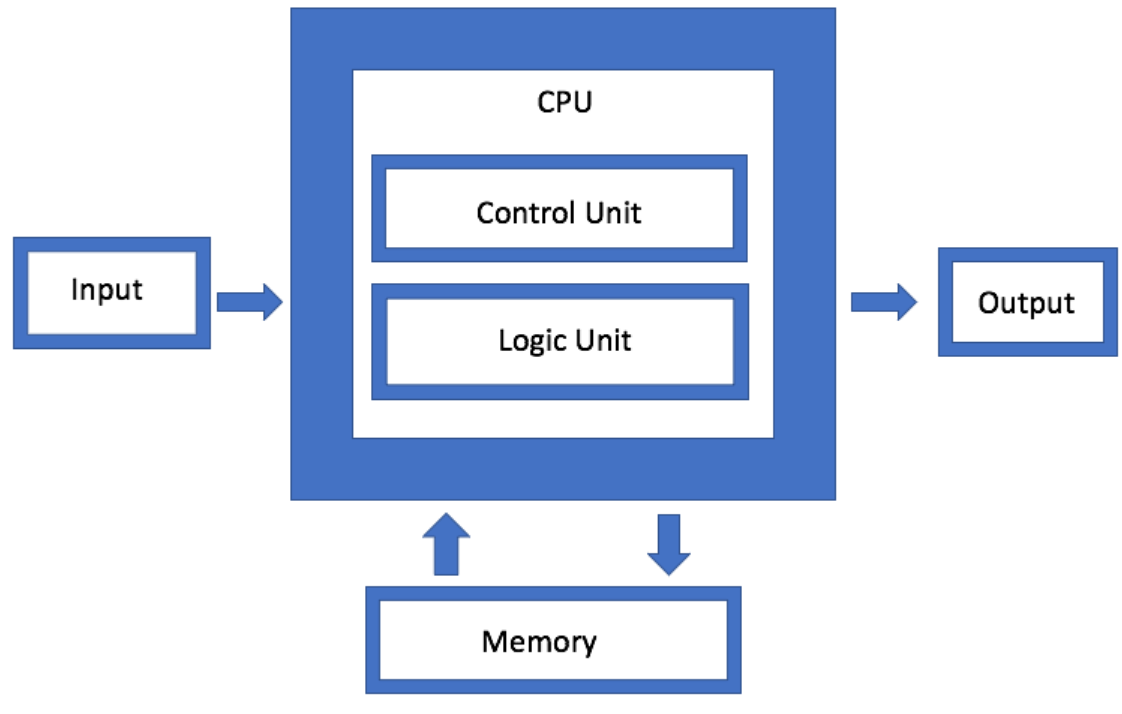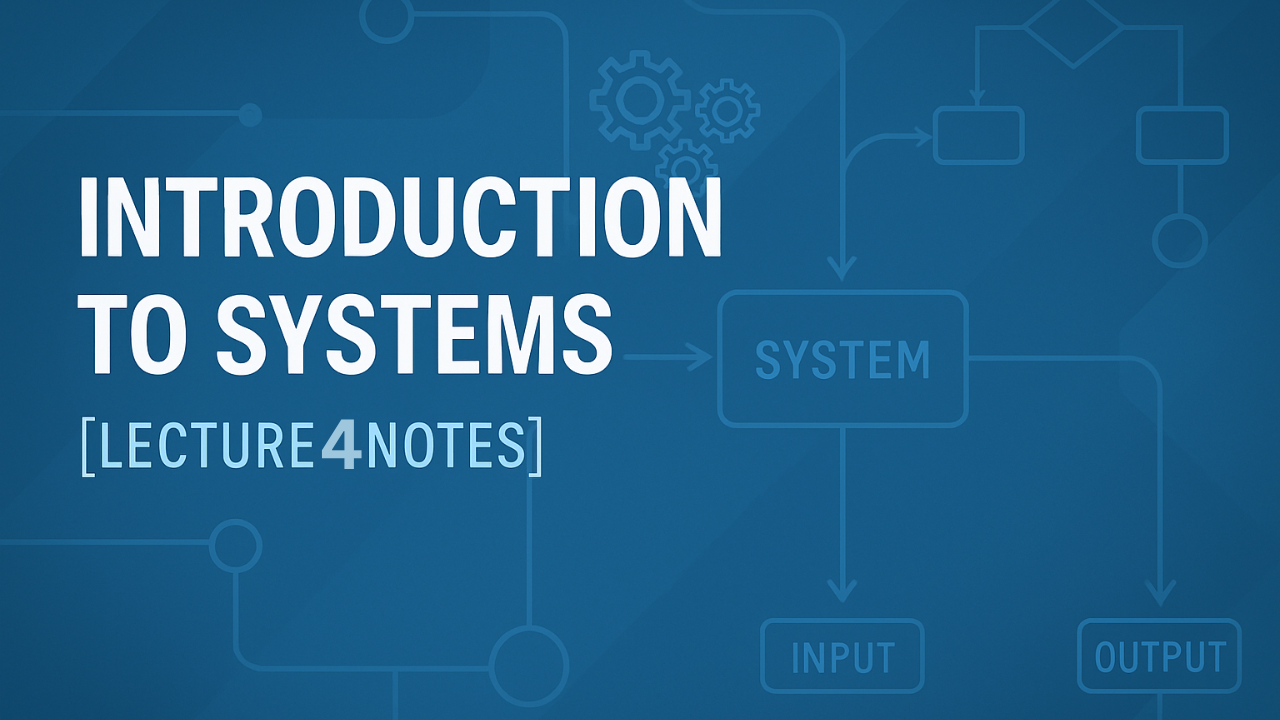Von Neumann Architecture
The Von Neumann architecture is a model of computer design with four main parts: Memory, CPU, Input devices, and Output devices. Proposed by John von Neumann in the 1940s.
Components

- Memory: Stores both data and program instructions for the CPU.
Example: RAM stores a program for faster execution than hard disk. - CPU: Executes instructions from memory and performs calculations.
Subcomponents:- Arithmetic Logic Unit (ALU): Performs math and logical operations. Example: Adding 2 + 2
- Control Unit (CU): Manages CPU operations and directs ALU and memory. Example: CU supervises ALU steps
- Input Devices: Allow users to enter data. Examples: Keyboard, mouse, microphone
- Output Devices: Show results. Examples: Monitor, printer
- System Bus: Connects all components. Types: Data Bus, Address Bus, Control Bus
CPU Working (Fetch, Decode, Execute, Store)
- Fetching: CPU retrieves an instruction from memory using Program Counter (PC) and Instruction Register (IR). Example: PC points to “Add 2 + 2” instruction and IR stores it.
- Decoding: Control Unit interprets the instruction. Example: CU identifies addition operation and selects required ALU operation.
- Execution: ALU performs calculations; CU coordinates data flow. Example: ALU adds 2 + 2 → result 4.
- Storing (Write-back): Result stored in memory or sent to output. Example: Sum (4) stored in memory and displayed on monitor.
Characteristics & Advantages/Disadvantages
- Single Memory Store: Data and instructions share memory. Example: Game code + player scores in RAM
- Sequential Execution: Instructions processed one by one
- Stored Program Concept: Programs stored in memory can be updated
- Advantages: Simplified design, easy to modify programs
- Disadvantages: Von Neumann bottleneck (single memory limits CPU speed), security risk (data + instructions together)
Computing Systems
A computing system is a structured set of hardware and software designed to process data and perform tasks. Objectives: Solve problems, control processes, manage data, aid communication.
- Hardware: CPU, RAM, storage, input/output devices
- Software: System software (OS) & Application software
- Types: Computers, Software Systems, Computer Networks, Internet
Computer Networks as Systems
A network connects computers/devices for resource sharing, communication, and data management.
- Networking Hardware: Routers, Switches, Network cables
- Network Software: Protocols (TCP/IP), Network OS (Windows Server)
Internet as a System
The Internet is a global network for communication and data exchange.
Internet Protocols
- TCP/IP: Governs reliable data transfer over the Internet
- UDP: Sends data quickly without error checking
- FTP: Transfers files between computers over a network
- POP: Retrieves emails from mail server to local device
Extra Insights / Expanded Knowledge
- Von Neumann Bottleneck: Single memory for instructions and data can slow CPU.
Insight: CPU caches were developed to reduce this bottleneck.
- CPU Optimization: Efficient ALU + CU improves processing speed.
Insight: Reduces energy consumption and computation time.
- Networking Protocols: TCP/IP, UDP, FTP, and POP manage data flow across networks.
Insight: Choosing the right protocol is critical for reliability and speed.
- Memory Management: Efficient RAM and storage usage improves system performance.
Insight: Virtual memory helps run large programs smoothly.
- Input/Output Devices: Proper device selection impacts user efficiency.
Insight: Fast SSDs, high-resolution monitors, and responsive keyboards improve workflow.
- System Bus: Acts as a highway connecting CPU, memory, and devices.
Insight: Wider buses allow faster data transfer and improved overall performance.
- Fetch-Decode-Execute Cycle: Central to CPU operation, ensures sequential instruction processing.
Insight: Pipeline architectures can improve CPU throughput by handling multiple instructions simultaneously.
- Stored Program Concept: Programs stored in memory can be modified dynamically.
Insight: Enables software updates without changing hardware.
- Internet Protocol Choice: Protocols like TCP/IP and UDP have different use cases.
Insight: TCP/IP ensures reliability for file transfers, while UDP is preferred for streaming and gaming due to lower latency.
- Output Devices Efficiency: Fast and accurate output devices enhance user experience.
Insight: High refresh rate monitors and low-latency printers improve response time in critical applications.
MCQs
- Which component executes instructions in a Von Neumann computer?
a) Memory
b) CPU ✅
c) Input Device
d) Output Device - Which unit performs arithmetic and logical operations?
a) Control Unit
b) ALU ✅
c) RAM
d) System Bus - What does the Program Counter (PC) do?
a) Stores data permanently
b) Holds address of next instruction ✅
c) Executes operations
d) Controls input devices - Which bus transmits control signals?
a) Data Bus
b) Address Bus
c) Control Bus ✅
d) Power Bus - Which protocol is used for reliable Internet data transfer?
a) UDP
b) FTP
c) TCP/IP ✅
d) POP
Frequently Asked Questions (FAQs)
John von Neumann, a mathematician and physicist in the 1940s.
Arithmetic Logic Unit (ALU) and Control Unit (CU).
A structured set of hardware and software designed to process data and perform tasks.
TCP/IP and UDP.
Single memory for instructions and data, limiting CPU speed.
